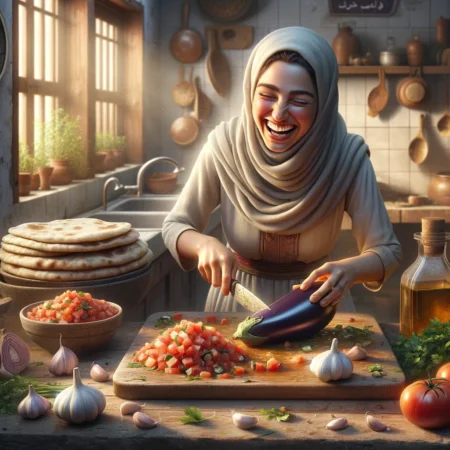Sweeping deserts, ancient ruins, bustling bazaars: Iran, or as many know it, Persia. A land that bridges East and West, that’s as enigmatic as it is beautiful. Yet, amidst its countless tales, there’s one that’s sung at dinner tables, one that brings people together in a shared experience of tradition and taste: the tale of Sabzi Khordan.
Travel with me to the city of Isfahan, back when it was the beating heart of the Persian Empire. The city’s grandeur, with its mosaic-clad mosques and intricate bridges, was only rivaled by the splendor of its royal feasts. But, for all their opulence, the royals felt something was missing. An element that would speak of Persia’s vast landscapes and its rich tapestry of cultures.
Enter Farid, a humble herb trader from the outskirts of the empire, who had traversed the Silk Road, learning the secrets of herbs and spices. He believed in the power of simplicity, in the magic that happens when fresh herbs are allowed to sing their songs without much ado.
Recognizing the royal dilemma, he presented Sabzi Khordan, a mix not of dried spices, but of fresh herbs. Fragrant mint, reminiscent of cool breezes in desert nights; crisp parsley, evoking the green oases that dotted the landscape; and aromatic tarragon, echoing the wildness of Persia’s vast terrains. To this, Farid added radishes for a bite and creamy feta to balance the herbs’ vibrancy.
The result was not just a spice blend, but a celebration of life itself. Each bite, crisp and aromatic, told stories of nomads, of caravanserais, of an empire that spanned continents.
The royal feasts of Isfahan were forever transformed. Sabzi Khordan wasn’t just another dish; it was an experience, a journey through Persia’s varied landscapes. And while kings and queens reveled in its freshness, its true magic lay in its accessibility. From the opulent halls of palaces to the humble abodes of peasants, Sabzi Khordan became a shared language, a piece of Persia on every plate.
The centuries rolled on, empires rose and fell, but the allure of Sabzi Khordan remained undiminished. As poets penned verses in the gardens of Shiraz or scholars debated in the libraries of Tehran, this simple blend of herbs and accompaniments continued to grace tables, bringing with it a sense of nostalgia and unity.
Fast forward to modern Iran, where tradition and modernity coalesce. In the vibrant streets of Tehran, amidst the hum of traffic and the aroma of kebabs, if you listen closely, you can still hear the whispers of the past. At family gatherings, amidst laughter and tales, Sabzi Khordan continues to play its part, a bridge to a time long gone.
Today, as you sit in an Iranian home, watching the sunset paint the sky in hues of gold and purple, a plate of Sabzi Khordan is sure to be passed around. And as you take a bite, savoring the medley of flavors, you’re not just tasting herbs. You’re partaking in a legacy, in tales of emperors and traders, of vast deserts and verdant valleys.
So, if you ever find yourself amidst Iran’s landscapes, with its majestic ruins and winding bazaars, remember to seek out this timeless blend. Let Sabzi Khordan take you on a journey, where every bite tells a story, where the essence of Persia comes alive, one herb at a time.
Sabzi Khordan (Iranian Herb and Cheese Platter)
A refreshing assortment of fresh herbs, cheese, walnuts, and radishes that represent the flavors and traditions of Iran. Sabzi Khordan is typically enjoyed with flatbread as a starter or alongside a main dish.
Ingredients
- A bunch of fresh mint leaves
- A bunch of fresh basil leaves
- A bunch of fresh cilantro (coriander)
- A bunch of fresh tarragon
- A bunch of fresh chives
- 1 cup feta cheese or any soft white cheese
- 1 cup walnuts
- 6-8 radishes, washed and trimmed
- Lavash or other flatbread, for serving
Directions
- Begin by washing and patting dry all the fresh herbs. Arrange them in bunches.
- On a serving platter or a large plate, spread out the fresh herbs.
- Place the feta cheese or soft white cheese in the center of the platter.
- Sprinkle walnuts around the cheese.
- Scatter the radishes on the platter.
- Serve Sabzi Khordan with pieces of lavash or other flatbread. Guests can create their own bite by wrapping herbs, cheese, a walnut, and a piece of radish in a piece of bread.
Tips & Tricks: Sabzi Khordan is customizable. Some families might add additional herbs or even fruits like pomegranate seeds for a sweet touch. The key is to use fresh, high-quality ingredients. You can also sprinkle some sumac over the cheese for an added tangy flavor. Sabzi Khordan is more than a dish; it’s a cultural experience meant to be shared with loved ones.





